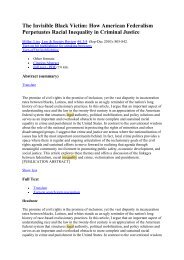Ski – resort and regional development: profile of visitors ... - E-Journal
Ski – resort and regional development: profile of visitors ... - E-Journal
Ski – resort and regional development: profile of visitors ... - E-Journal
You also want an ePaper? Increase the reach of your titles
YUMPU automatically turns print PDFs into web optimized ePapers that Google loves.
The carrying capacity <strong>of</strong> mountainous tourist areas: the case <strong>of</strong> plastira’s lake<br />
2. Planning <strong>of</strong> work taking into consideration the carrying capacity (meaning the resistance)<br />
<strong>of</strong> the ecosystems <strong>and</strong> the biological diversity.<br />
3. Development <strong>of</strong> tourism activities in combination with the application <strong>of</strong> uses <strong>and</strong> practices<br />
friendly to the environment.<br />
4. Planning <strong>of</strong> tourism, in such a way that it is not a burden to only one part <strong>of</strong> the area but<br />
being spread spatially <strong>and</strong> temporally, causing the least possible consequences in the<br />
protected areas.<br />
5. Planning <strong>of</strong> material <strong>and</strong> technical infrastructure taking into consideration the saving <strong>of</strong><br />
energy, the guaranteed cleaning <strong>of</strong> waste <strong>and</strong> the taking <strong>of</strong> remedial measures for the<br />
protection <strong>of</strong> the local environment.<br />
6. Participation <strong>of</strong> the institutions <strong>of</strong> exploitation <strong>of</strong> ecotourism activities in local, national<br />
<strong>and</strong> international action <strong>of</strong> environmental protection.<br />
According to the rules above, we could say for the area <strong>of</strong> Plastira's Lake the following:<br />
• Tourism <strong>development</strong> should consist <strong>of</strong> a lot <strong>of</strong> infrastructures on a small scale, which<br />
would push forward local characteristics <strong>of</strong> each area without being an excessive burden<br />
to the local environment. In the bibliography a proportion <strong>of</strong> six (6) tourist beds per 100<br />
permanent residents is reported indicatively, which is considered not to aggravate the<br />
natural <strong>and</strong> cultural environment <strong>of</strong> the reception area. The proportion can, in a lot <strong>of</strong> cases<br />
be bigger without causing problems, but when a limit (e.g. <strong>of</strong> 50 per 100) is exceeded the<br />
problems <strong>of</strong> mass tourism are noticeable.<br />
• Tourism activities in the areas <strong>of</strong> natural protection should be strictly controlled, spatially<br />
<strong>and</strong> temporally spread in such a way that local micro-environments are not disturbed by<br />
continuous visits at the same place. Important role in the achievement <strong>of</strong> this aim plays<br />
the establishment <strong>of</strong> a network <strong>of</strong> paths with specific labelling that will lead the visitor<br />
only to those places which have been evaluated as suitable for visits. Especially in the<br />
sensitive areas, visits should be made with the escort <strong>of</strong> guardian-ecotour-guide. In the<br />
periods <strong>of</strong> fauna-reproduction the visits in the sensitive places can be replaced by extensive<br />
<strong>and</strong> detailed information using maps, booklets, posters, models, slides <strong>and</strong> films in the<br />
Information Centre.<br />
• The infrastructures that will be created (guest rooms, recreation infrastructures etc.) should<br />
be adapted to the local environment <strong>and</strong> should have environmentally, friendly planning.<br />
In the cases <strong>of</strong> monument promotion, particular attention should be paid to the spatial<br />
conservation because, as UNESCO underlines «a monument loses important part <strong>of</strong> its<br />
attractiveness when it is separated from the elements that surrounds it (small buildings,<br />
Tourism Today - Fall 2007 - Full Paper<br />
119














